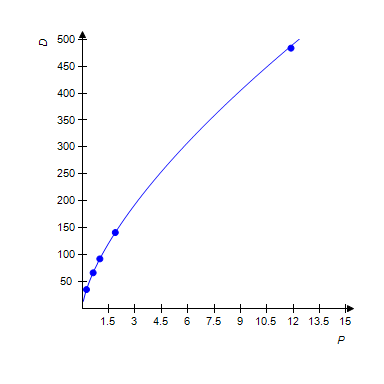The following data show the distance D, in millions of miles, and the period P, in years, of five of the planets. (The period is the time required for one revolution about the sun.)
Planet Mercury Venus Earth Mars Jupiter P 0.24 0.62 1 1.88 11.87 D 36 67.1 92.9 141.7 483.4?
A: Use power regression to model the distance as a function of the period. Use two digits of accuracy for the coefficient and for the power.B: Plot the data along with the power model you found in part A.C: If one planet takes twice as long to orbit the sun as another, how do their distances from the sun compare? Round your to two decimal places.
What will be an ideal response?

?
B:
?
?
C: The planet with the longer period is 1.59 times as far away from the sun as the planet with the shorter period.
You might also like to view...
Determine if the sequence is geometric. If the sequence is geometric, find the common ratio.4, -12, 36, -108, 324, . . .
A. yes, 12
B. yes, - 
C. no
D. yes, -3
Ivan wishes to determine which antenna he should purchase for his home. The TV store has supplied him with the information: Range in Miles VHF UHF Model Price 30 20 A $40 45 35 B $50 60 40 C $60 75 55 D $70 Ivan wishes to receive Channel 17 (VHF) that is located 20 mi east and 45 mi north of his home and Channel 38 (UHF) that is located 23 mi south and 33 mi west of his home. Which model will allow him to receive both channels at the least cost? (Assume that the terrain between Ivan's home and both broadcasting stations is flat.)Model __________
What will be an ideal response?
Find the monthly mortgage payment.

A. $1174.66 B. $1161.06 C. $882.82 D. $748.94
Find the area of the rectangle or square.Length = 12 cm, width = 3 cm
A. 30 cm2 B. 36 cm2 C. 15 cm2 D. 72 cm2
